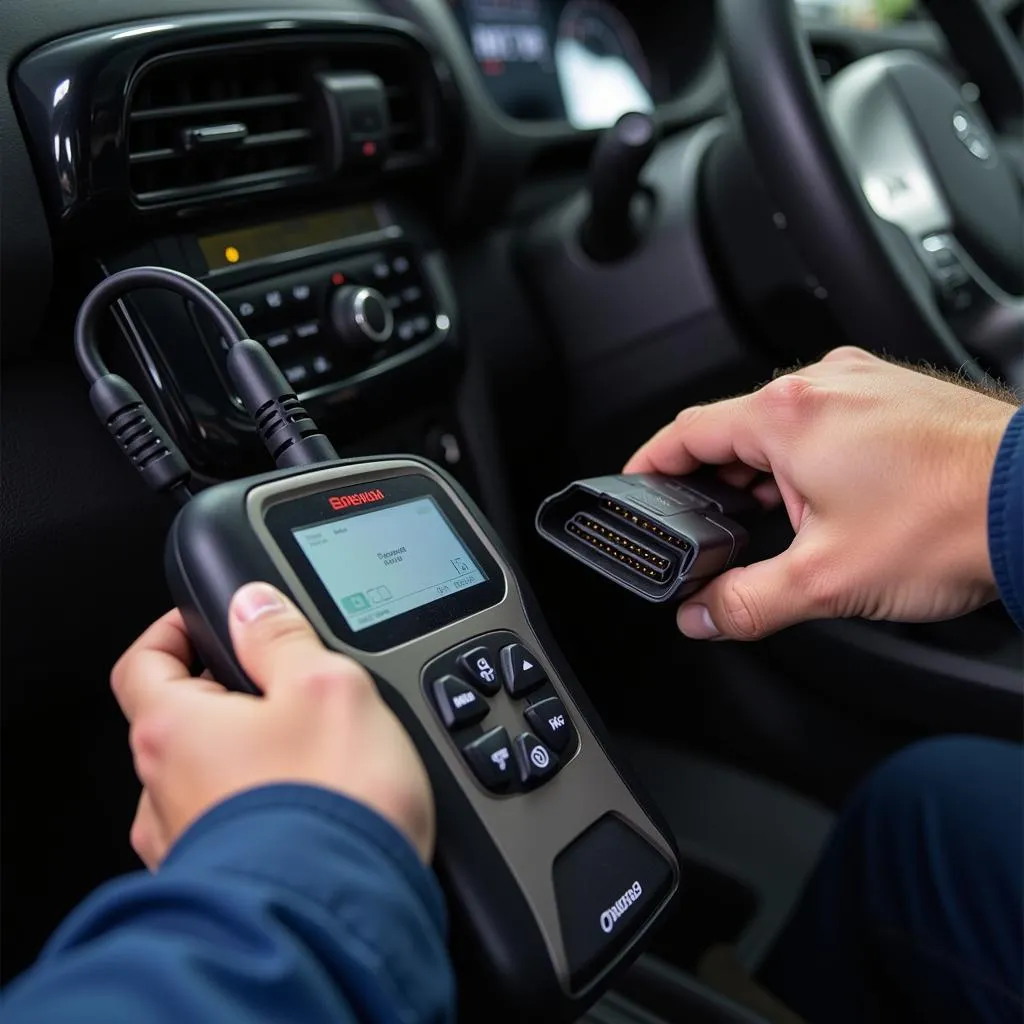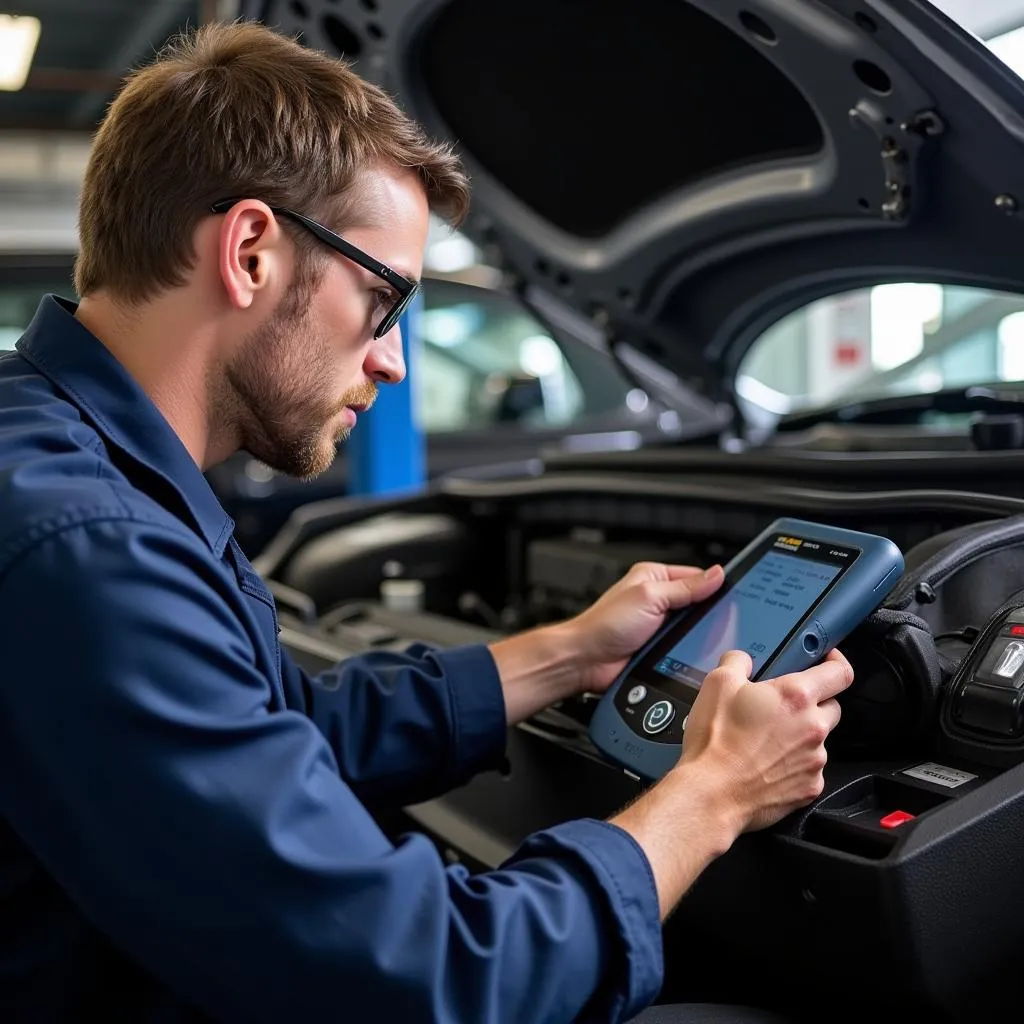Modern vehicles are more than just mechanical marvels; they’re sophisticated computers on wheels. And when something goes wrong, it takes more than a wrench and a hunch to diagnose the issue. That’s where computer diagnostic auto tools come in. These powerful devices have revolutionized the way mechanics troubleshoot and repair vehicles, providing a deep dive into the electronic systems that control everything from engine performance to safety features.
What is Computer Diagnostic Auto?
Computer diagnostic auto, also known as onboard diagnostics or OBD, refers to the process of using specialized software and hardware to communicate with a vehicle’s computer system. This system, often referred to as the Engine Control Unit (ECU), monitors various sensors throughout the vehicle, collecting data on performance, emissions, and potential faults.
 Car Connected to Diagnostic Tool
Car Connected to Diagnostic Tool
The Importance of Computer Diagnostic Auto in Modern Vehicle Repair
Gone are the days of relying solely on mechanical expertise and intuition to fix car problems. Today’s vehicles are heavily reliant on electronics, making computer diagnostic auto tools indispensable for several reasons:
- Accurate Diagnosis: These tools provide precise information about the source of a problem, eliminating guesswork and unnecessary repairs.
- Enhanced Efficiency: By quickly identifying the root cause, mechanics can streamline the repair process, saving time and money for both the shop and the vehicle owner.
- Access to Complex Systems: Modern vehicles come equipped with intricate systems like anti-lock brakes (ABS), airbags, and advanced driver-assistance systems (ADAS). Computer diagnostics allow mechanics to access and troubleshoot these complex electronic components.
- Emission Control: Diagnostic tools play a crucial role in ensuring vehicles meet emission standards. By analyzing exhaust data, they can identify and help rectify issues that contribute to pollution.
Types of Computer Diagnostic Auto Tools
There’s a wide array of computer diagnostic auto tools available, catering to different needs and budgets. These range from basic code readers to advanced professional-grade scanners. Here’s a breakdown:
-
Code Readers: These handheld devices are the most basic type, designed to read and display diagnostic trouble codes (DTCs) stored in the vehicle’s ECU. While they provide a starting point for diagnosis, they typically don’t offer detailed information or advanced functions.
-
OBD-II Scanners: A step up from code readers, OBD-II scanners offer more comprehensive data, including live sensor readings, freeze-frame data (snapshots of vehicle parameters at the time a fault code was stored), and the ability to clear fault codes.
-
Professional-Grade Scanners: These sophisticated tools are used by experienced technicians and offer a wide range of advanced features, including:
- Bi-directional control: Allows mechanics to interact with vehicle systems, such as activating components for testing.
- Programming and Coding: Enables the reprogramming of certain modules and the configuration of vehicle settings.
- Advanced Diagnostics: Provides access to manufacturer-specific data and advanced troubleshooting capabilities.
 Mechanic Using Diagnostic Scanner
Mechanic Using Diagnostic Scanner
How to Choose the Right Computer Diagnostic Auto Tool
Selecting the right computer diagnostic auto tool depends on your specific needs and level of expertise. Here are key factors to consider:
- Vehicle Compatibility: Ensure the tool is compatible with the make, model, and year of your vehicle or the vehicles you intend to service.
- Features and Functionality: Determine the specific features you require, such as code reading, live data, bi-directional control, or programming capabilities.
- User Interface: Opt for a tool with an intuitive and user-friendly interface, especially if you’re a beginner.
- Software Updates: Choose a tool that offers regular software updates to ensure compatibility with the latest vehicle models and technology.
- Budget: Set a budget beforehand and explore options within your price range, considering the long-term value and potential return on investment.
The Future of Computer Diagnostic Auto
The automotive industry is in a constant state of evolution, with technological advancements rapidly shaping the future of vehicle repair. Here are some trends to watch out for in the world of computer diagnostic auto:
- Increased Vehicle Complexity: As vehicles become more technologically advanced, with features like autonomous driving and electric powertrains, the need for sophisticated diagnostic tools will only grow.
- Remote Diagnostics: The rise of telematics and connected cars is paving the way for remote diagnostics, allowing mechanics to diagnose problems and potentially even resolve them without the vehicle being physically present in the shop.
- Predictive Maintenance: Advanced diagnostics and data analysis will enable predictive maintenance, where potential issues are identified and addressed before they escalate into major problems, minimizing downtime and repair costs.
- Augmented Reality and Virtual Reality: AR and VR technologies are poised to revolutionize the way mechanics interact with vehicle systems, providing immersive and intuitive diagnostic experiences.
Conclusion
Computer diagnostic auto tools have become essential in modern vehicle repair, offering accurate diagnoses, improved efficiency, and the ability to handle increasingly complex electronic systems. As technology continues to advance, these tools will only become more sophisticated and indispensable. Whether you’re a professional mechanic or a DIY enthusiast, understanding and utilizing computer diagnostics is crucial for navigating the ever-evolving world of automotive repair.
FAQ
-
What does a check engine light mean?
A check engine light indicates a potential problem detected by the vehicle’s onboard diagnostic system. It’s crucial to use a computer diagnostic auto tool to read the specific fault code and determine the underlying issue. -
Can I use any OBD-II scanner on my car?
While most cars manufactured after 1996 are equipped with the OBD-II standard, it’s essential to check for compatibility with your specific make, model, and year to ensure proper functionality. -
Do I need a professional-grade scanner for basic car maintenance?
For routine maintenance like oil changes or brake pad replacements, a basic code reader or OBD-II scanner might suffice. However, for more complex repairs or advanced diagnostics, a professional-grade scanner is recommended.
Common Scenarios When You Need Computer Diagnostic Auto
- Check Engine Light is On: This is the most common scenario, indicating a potential problem with the engine, emissions system, or other critical components.
- Transmission Issues: Slipping gears, rough shifting, or warning lights on the dashboard could point to problems within the transmission control module.
- Airbag System Malfunctions: If the airbag warning light is illuminated, it’s crucial to have the system diagnosed to ensure proper functionality in case of an accident.
- ABS Problems: Issues with the anti-lock braking system, such as a pulsating brake pedal or warning lights, require immediate attention and diagnosis.
- Performance Issues: Unexplained loss of power, reduced fuel efficiency, or rough idling can often be traced back to electronic issues requiring diagnostic tools for identification.
Need More Information?
Explore our website for in-depth articles on specific computer diagnostic auto topics:
- Semi Truck Diagnostic Computer
- Heavy Truck Scan Tool
- Truck Computer
- Automotive Computer Reprogramming Tools
- Semi Truck Diagnostic Tool
Get in Touch!
Need help choosing the right diagnostic tool or have questions about your vehicle’s computer system? Our team of experts is here to help!
Contact us:
- WhatsApp: +1(641)206-8880
- Email: [email protected]
- Address: 276 Reock St, City of Orange, NJ 07050, United States
We offer 24/7 customer support.